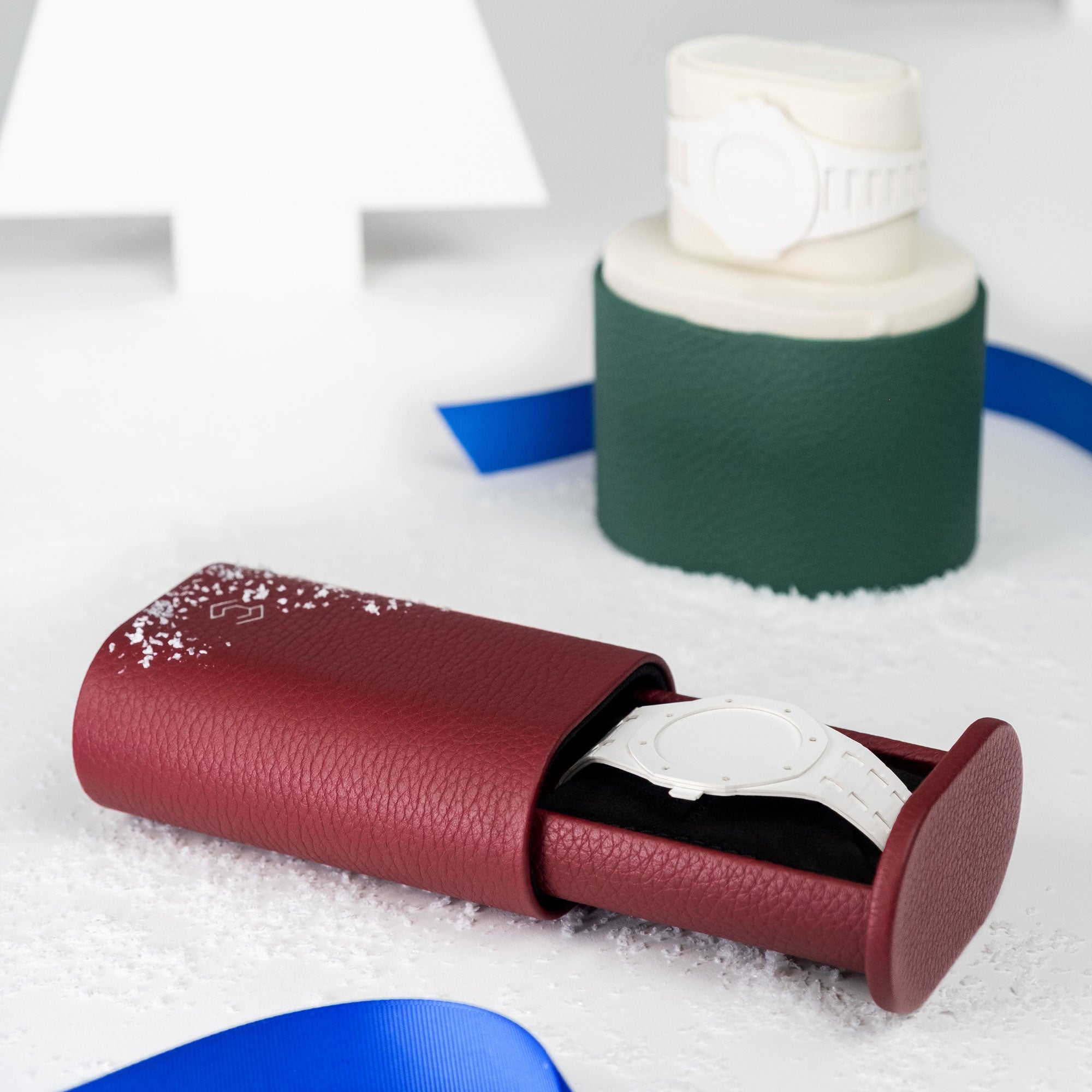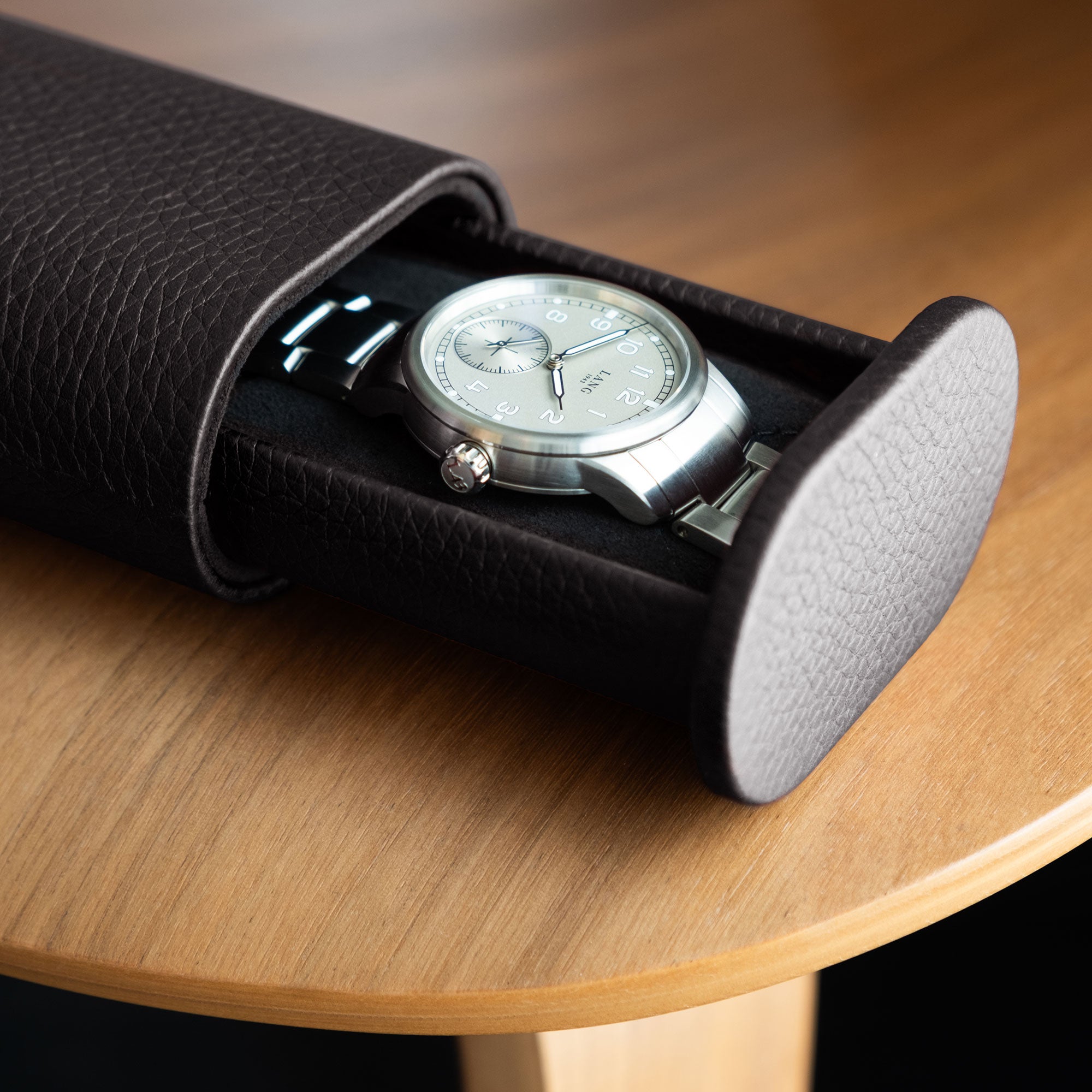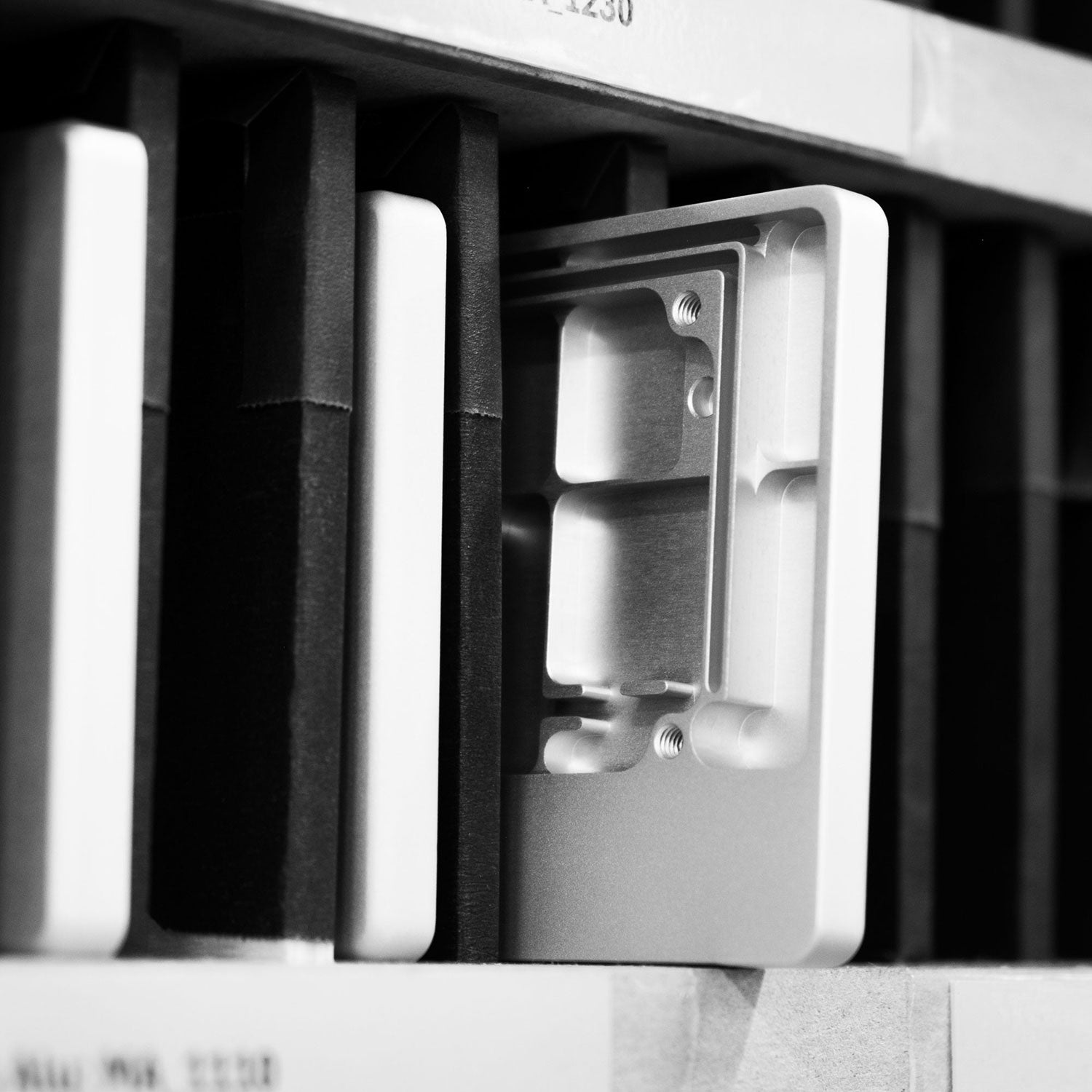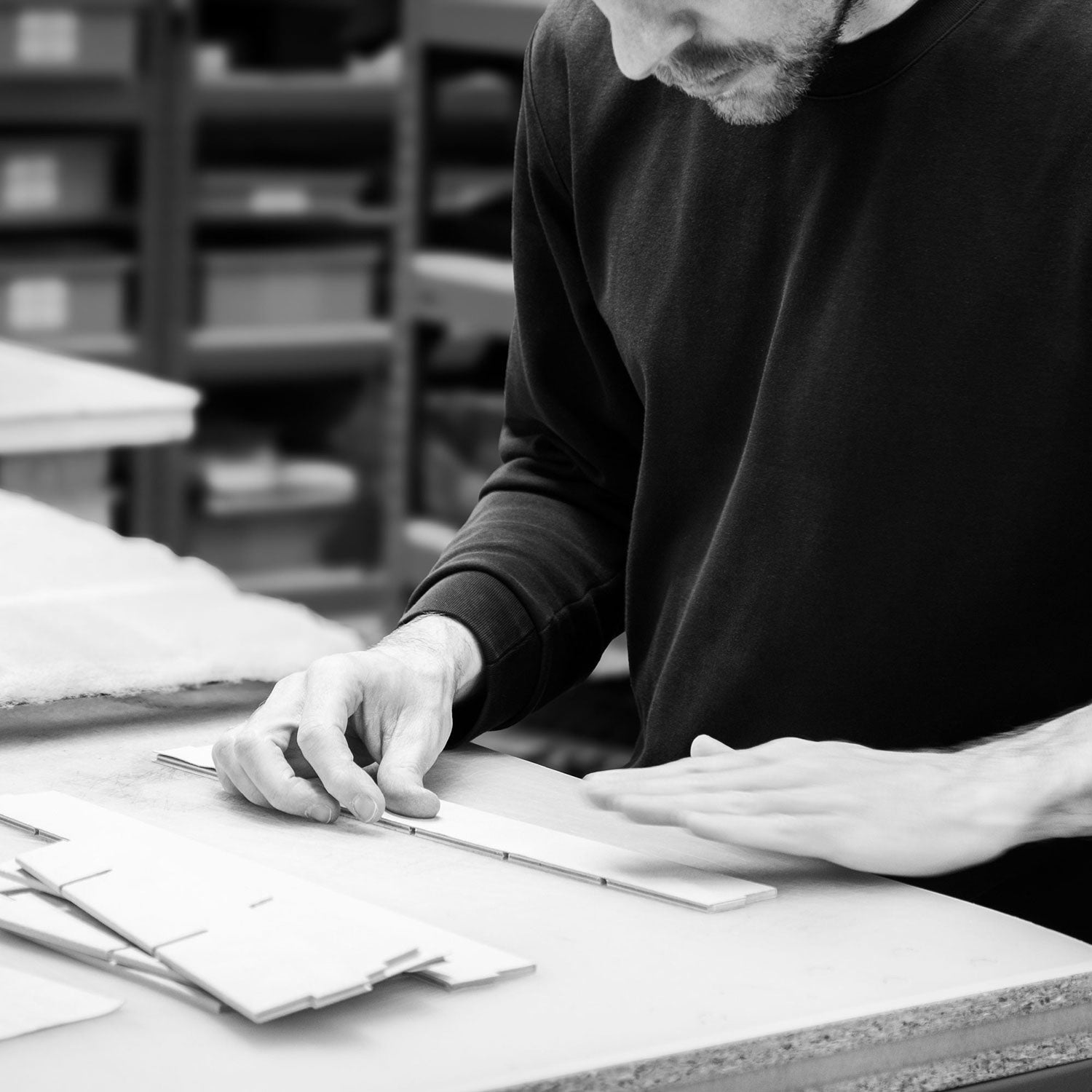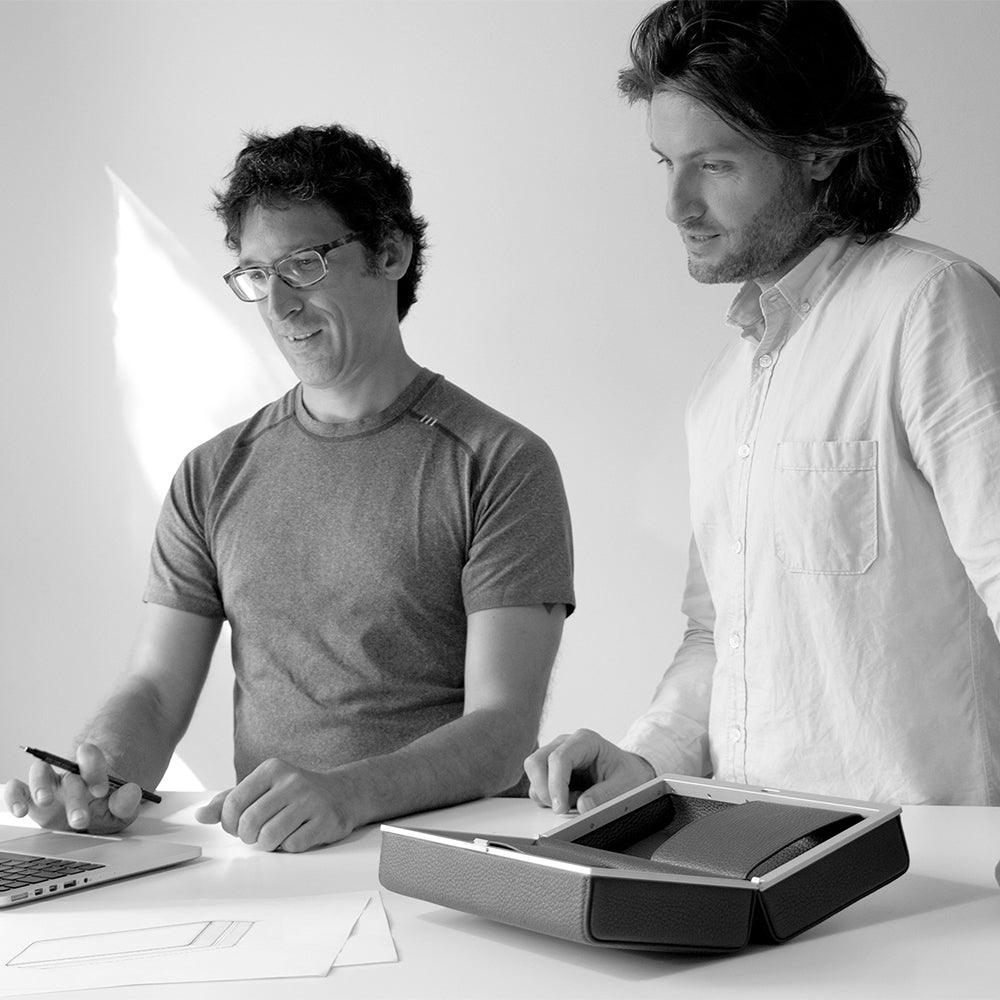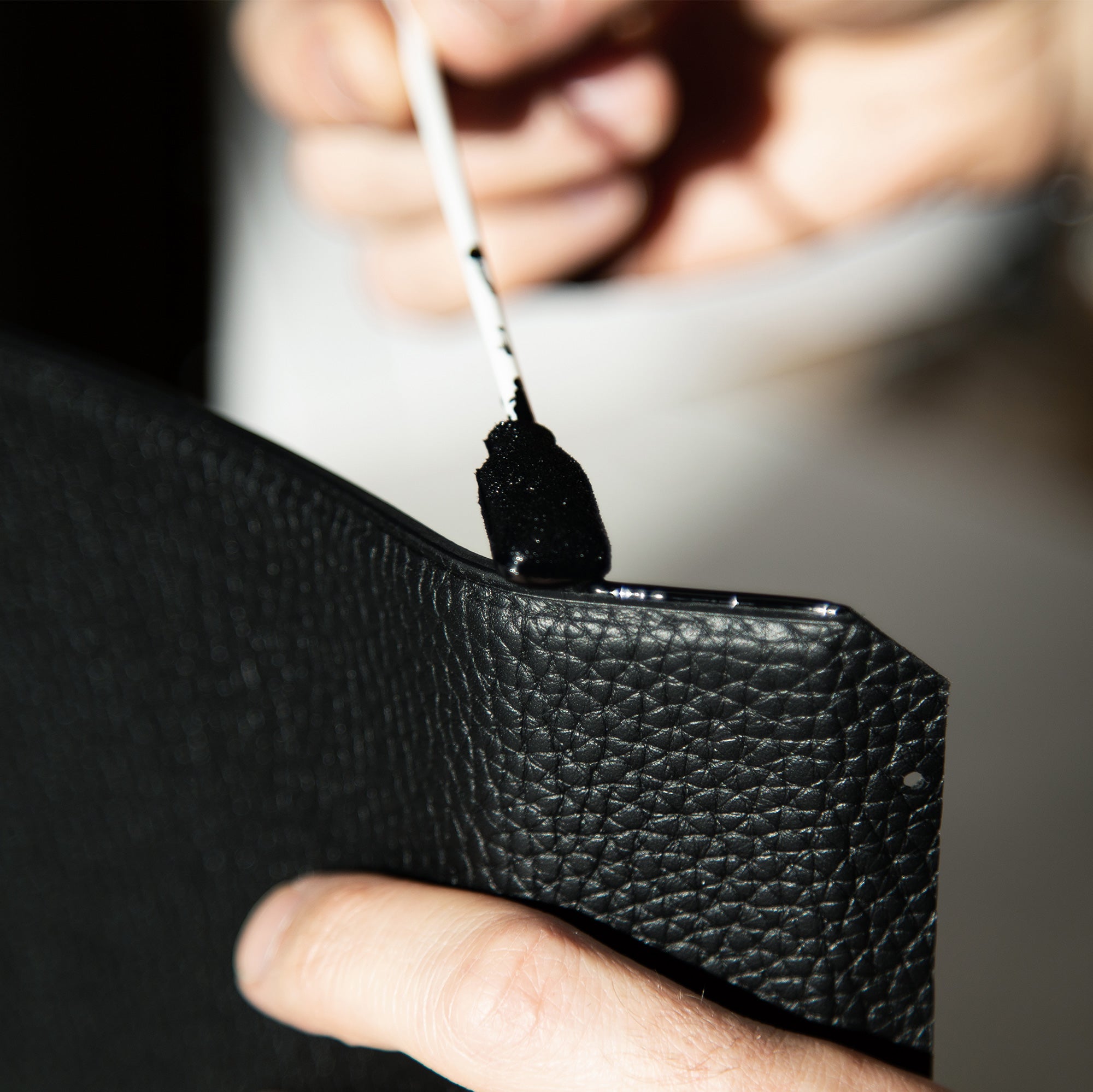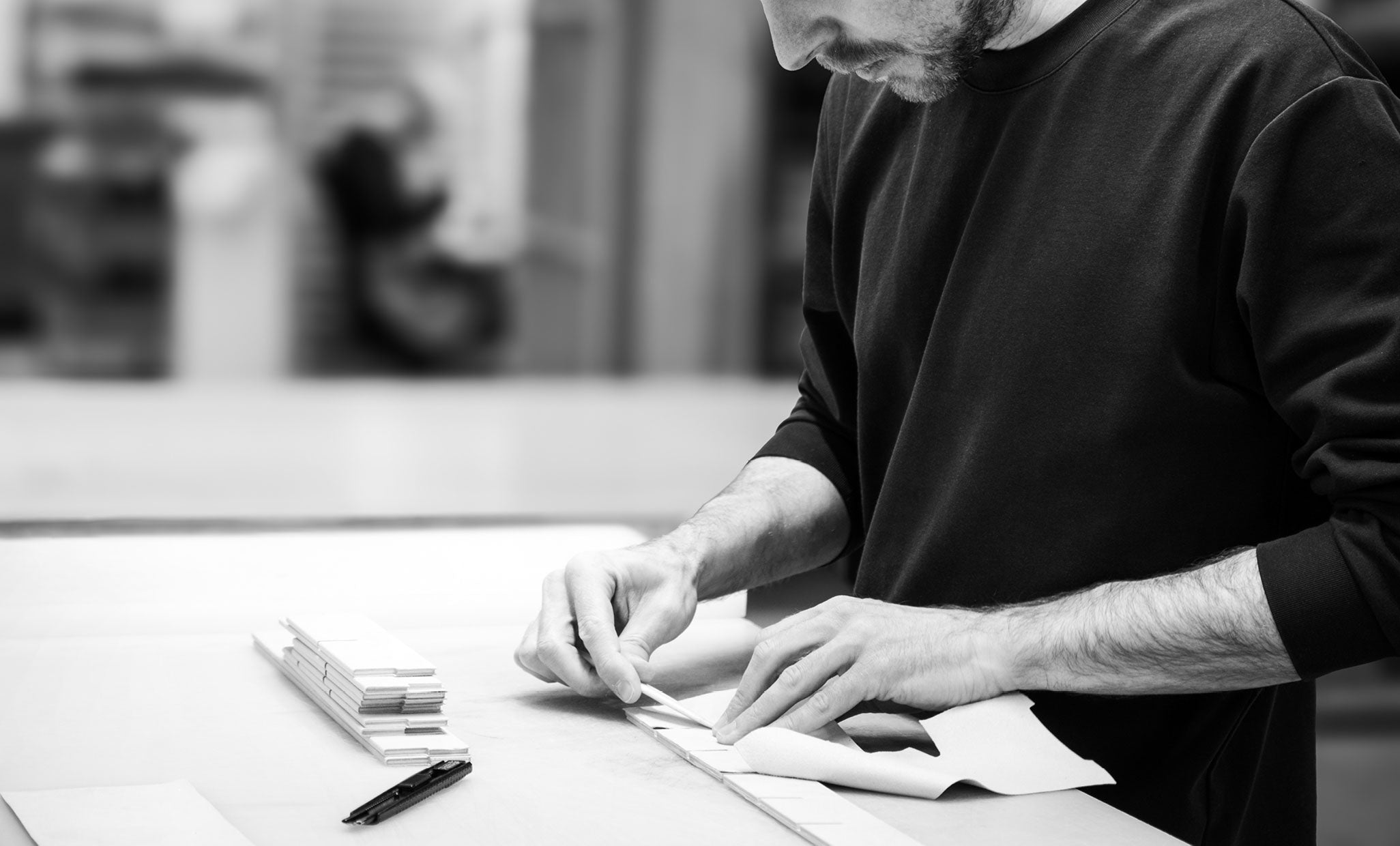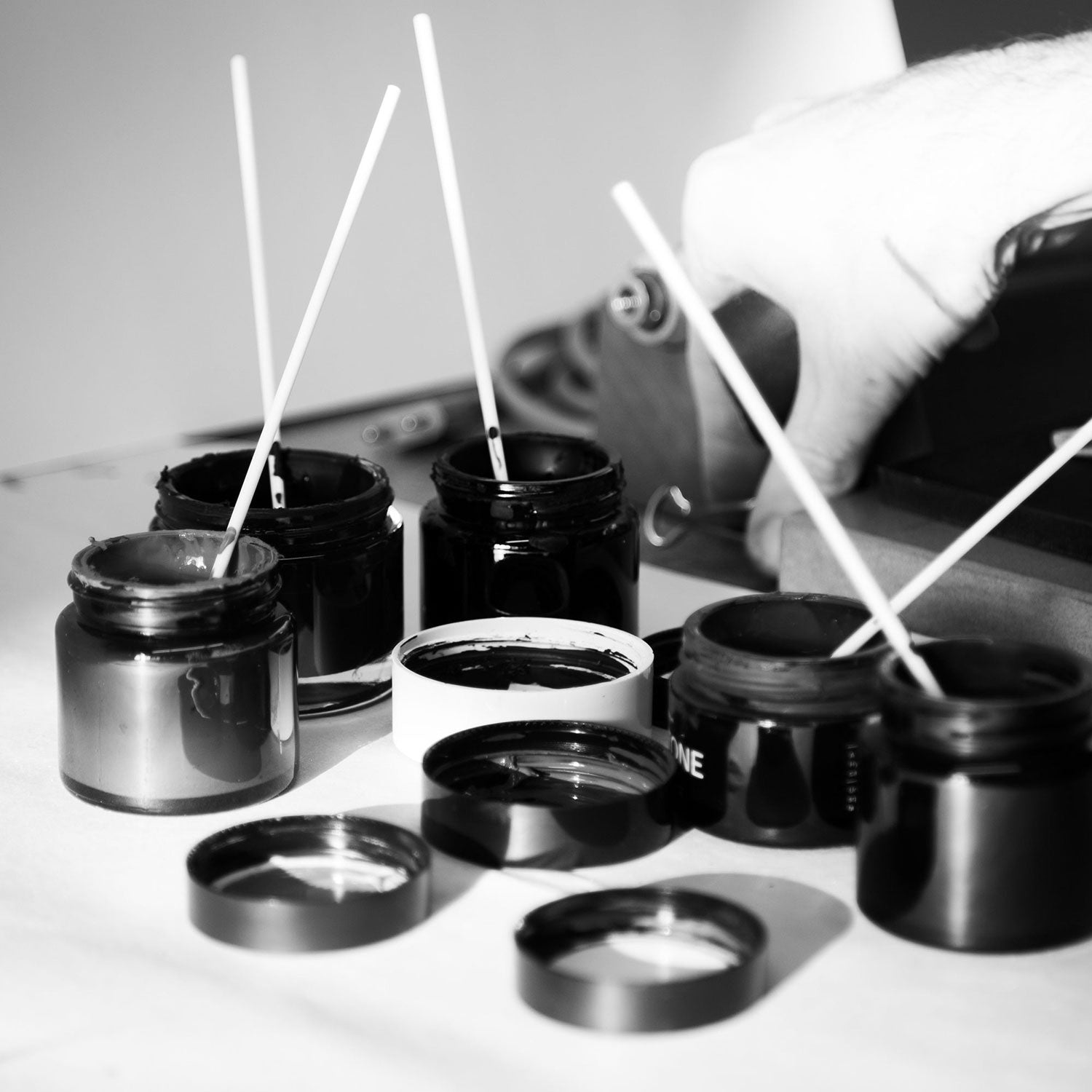Our creations are shaped by expert artisans whose profound knowledge, respect for the craft, and meticulous attention to detail embody the very best of contemporary craftsmanship.
Tools and Techniques
Our artisans work in close conversation with each material—guided by an understanding of its unique properties. Tools are not just instruments of precision, but conduits through which raw materials are transformed into refined forms. With each cut, each stitch, each finished edge, the material is shaped not only by skilled hands, but by the pursuit of reimagining the harmony between beauty and function.
Leather Work
Honoring the tactile beauty of leather through skilled craftsmanship
Template Cutting
Each leather panel is first cut using precise templates—ensuring the dimensions that shape the identity of the final piece. This step demands meticulous accuracy, as every handmade cut determines how forms align and details come together. It is the initial translation of design into material, setting the tone of exactitude that guides the path forward.
Die Cutting
For components that require complete uniformity, leather is cut using a hydraulic press and custom dies. This technique—known as die cutting—combines force and finesse to produce perfectly replicated shapes with absolute accuracy.
Splitting
Before shaping begins, each leather hide is carefully split—a process that adjusts its thickness with exacting control. This step enables us to manage the material’s weight and flexibility, achieving structural integrity and consistency across components.
Leveling
As a natural material, leather bears subtle variations in thickness. To achieve flawless assembly, each panel is carefully leveled—calibrated to the nearest millimeter to ensure consistency and quality across every component.
Skiving
Before leather pieces can come together seamlessly, they are skived—delicately thinned along the edges to allow for clean folds and precise layering. This technique reduces bulk without compromising strength, enabling sharp lines and refined contours.
Punching
Punching is used to create precise openings and intricate shapes in the leather—whether for stitching, hardware placement, or the artistry of marquetry. With sharp tools and steady pressure, our artisans achieve clean cuts that preserve the integrity of the hide.
Molding
Molding transforms flat leather into sculpted form. The material is shaped to achieve seamless contours and tailored dimension, giving each piece a distinctive silhouette while maintaining the material's natural elegance.
Finition Sellier - Creasing
The edges of our leather accessories are creased in order to add definition and refinement. Using a heated tool, our artisans impress subtle lines along the seams to enhance both the visual finish and structural clarity of the piece. More than decoration, creasing sharpens the silhouette—a subtle gesture that reflects our meticulous attention to detail.
Finition Sellier - Tinting
After creasing, the edges are carefully hand-painted and sealed with pigments to either match or provide a tasteful contrast to the main leather color. This process not only enhances durability but also adds a polished finish.
Gluing
Gluing is an essential step in leather assembly, ensuring lasting cohesion. At Charles Simon, we use a water-based adhesive—chosen not only for its strong bonding properties but also for its environmentally responsible composition. Free from harmful fumes and solvents, it supports both artisan well-being and our efforts towards sustainable practices.
Stitching
Whether executed by hand or by machine under the careful guidance of an artisan, every stitch on a Charles Simon piece is made with intention and deliberation. We use premium thread sourced from Germany, chosen for its strength and durability to ascertain that every last detail meets our standards of excellence.
Finishing Touches
Refining each object to its highest expression
Embossing and Debossing
Embossing and debossing are defining enhancements that lend depth and identity to our creations. Whether raised (embossed) or recessed (debossed), each mark is applied with great care. Moreover, these techniques enable us to render a Charles Simon accessory truly unique, through the addition of logos, monograms, or bespoke designs that provide the ultimate personal touch.
Marquetry
Leather marquetry is a process that involves assembling intricate patterns or motifs from precisely cut pieces of leather. Each fragment is individually shaped and carefully inlaid by hand, requiring not only exceptional precision but a deep understanding of the material. This advanced technique allows for creative contrasts in color, grain, and finish, creating richly layered, complex compositions.
Hot Stamping
Hot stamping is a finishing technique that uses heat, pressure, and metal dies to imprint designs, logos, or text onto leather surfaces via metallic foil. The process requires exacting control to ensure clarity and depth without compromising the leather’s surface. At Charles Simon, hot stamping is most commonly used to apply subtle branding or personalized initials, giving our pieces a discreet signature. In addition, we create custom dies with bespoke motifs, allowing for unique impressions tailored to specific creations.
“Contemporary craftsmanship requires a process of constant reimagination—letting innovative ideas take shape through a tactile discourse with materials, guided by a deep respect for the trade and a quiet pursuit of excellence.”
Aluminum
Transforming aluminum into refined components through technical mastery
Machining
Machining is the process through which raw aluminum is shaped into precise components using advanced CNC technology. Each part is milled to exact specifications, ensuring seamless integration and optimal performance.
Polishing
Before anodization, each aluminum component undergoes hand-sanding and polishing to achieve a perfectly smooth surface. This essential preparation ensures that the final anodized finish is visually uniform and free of imperfections—enhancing both the durability and sleek aesthetic of the material.
Laser Engraving
Laser engraving allows us to inscribe precise, lasting details onto aluminum surfaces. Using advanced laser technology, each design is etched with accuracy. This technique fuses technical expertise with artistic expression, adding a distinctive, sleek signature to our accessories.
Technical Assembly
Assembly is a critical phase where precisely machined components are joined to ensure structural integrity and seamless operation. Our in-house team meticulously aligns and fastens each part, integrating complex mechanisms with exacting accuracy. This technical assembly process transforms individual elements into durable, high-performance structured, embodying the precision engineering that lies at the core of Charles Simon.
Lock Mechanism
Developed entirely in-house, our locking mechanism is engineered for smooth functionality, security, and seamless integration into our overall design. Every component is carefully machined and assembled by our specialists, giving us full control over both performance and aesthetics. The result is a mechanism that is as reliable as it is refined.
Woodwork
Honoring the material's natural beauty through refinement that stands the test of time
Machining
Machining is the initial step in transforming raw wood into precisely shaped components. Each piece is carefully cut, milled, and routed to exact specifications. This process allows us to achieve clean lines and consistent forms—laying the groundwork for seamless assembly.
Assembly
Each wooden component is joined with meticulous care, using techniques that preserve the natural integrity of the material while ensuring lasting durability. Every connection is aligned with exacting accuracy to create a unified whole.
Sanding
Sanding is an essential step in bringing out the full character of the wood. Through a series of progressively finer abrasives executed by hand, the surface is refined to a smooth, tactile finish. This process not only enhances the natural grain and warmth of the material, but also prepares it for the final protective treatments. In the hands of our skilled artisans, sanding becomes an act of revealing the wood’s natural beauty in its most polished form.
Protecting
Finally, each wooden component undergoes a meticulous finishing process involving a minimum of three protective coats. Applied carefully by hand, these layers form a resilient barrier that shields the wood from everyday wear. This final step preserves the integrity of the material in order to allow its beauty to endure through time and use.
More to Discover
Continue exploring the ideas, materials, and vision that shape the world of Charles Simon.

Our Story
Dive into Charles Simon’s founding story, our unique expertise and the guiding principles behind everything we do.
Learn more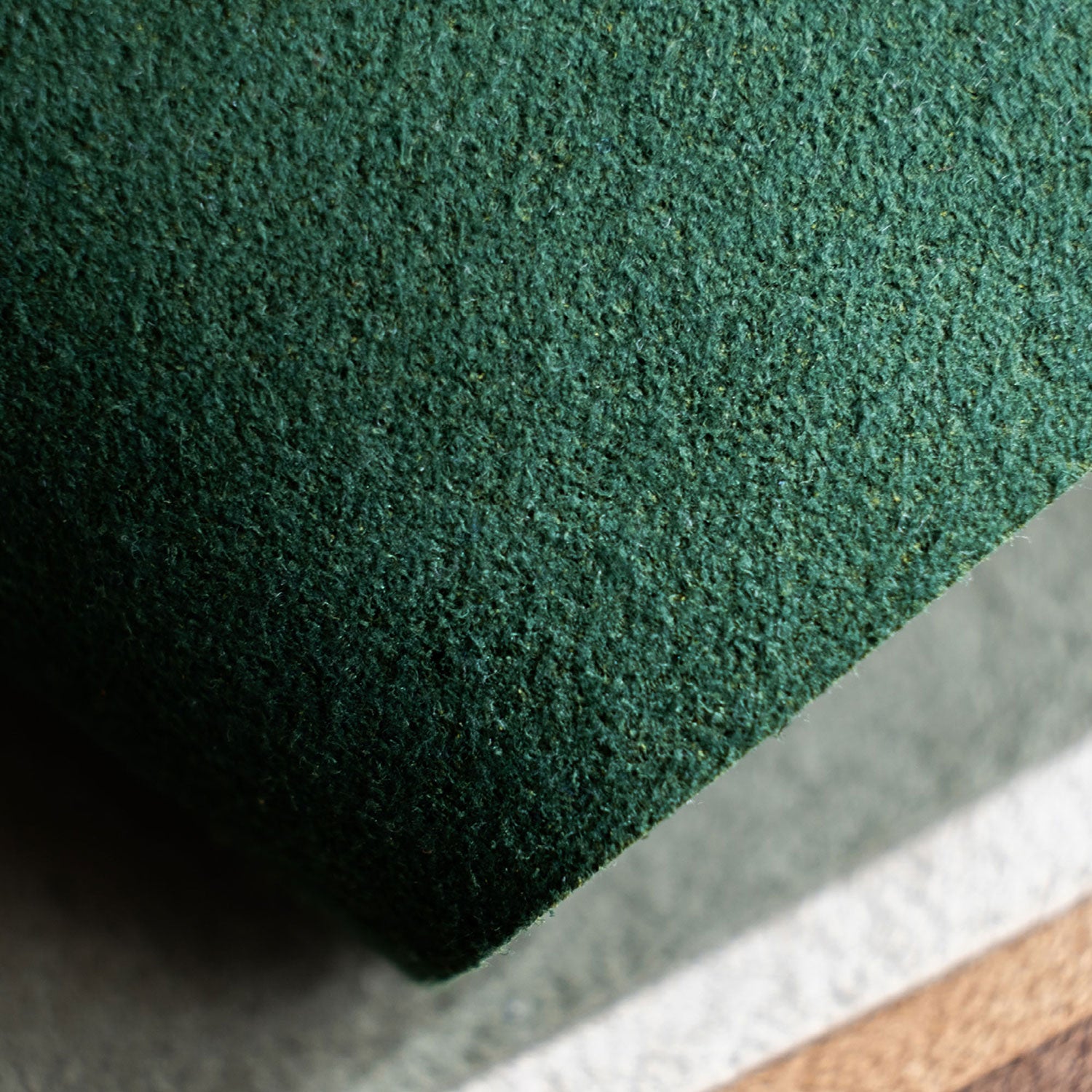
Our Materials
Explore the refined resources that make up Charles Simon accessories – selected for their tactile beauty, high performance and durability.
Learn more
